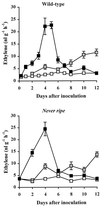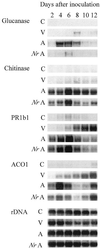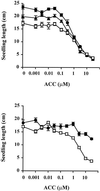Response to Xanthomonas campestris pv. vesicatoria in tomato involves regulation of ethylene receptor gene expression
- PMID: 10806227
- PMCID: PMC58984
- DOI: 10.1104/pp.123.1.81
Response to Xanthomonas campestris pv. vesicatoria in tomato involves regulation of ethylene receptor gene expression
Abstract
Although ethylene regulates a wide range of defense-related genes, its role in plant defense varies greatly among different plant-microbe interactions. We compared ethylene's role in plant response to virulent and avirulent strains of Xanthomonas campestris pv. vesicatoria in tomato (Lycopersicon esculentum Mill.). The ethylene-insensitive Never ripe (Nr) mutant displays increased tolerance to the virulent strain, while maintaining resistance to the avirulent strain. Expression of the ethylene receptor genes NR and LeETR4 was induced by infection with both virulent and avirulent strains; however, the induction of LeETR4 expression by the avirulent strain was blocked in the Nr mutant. To determine whether ethylene receptor levels affect symptom development, transgenic plants overexpressing a wild-type NR cDNA were infected with virulent X. campestris pv. vesicatoria. Like the Nr mutant, the NR overexpressors displayed greatly reduced necrosis in response to this pathogen. NR overexpression also reduced ethylene sensitivity in seedlings and mature plants, indicating that, like LeETR4, this receptor is a negative regulator of ethylene response. Therefore, pathogen-induced increases in ethylene receptors may limit the spread of necrosis by reducing ethylene sensitivity.
Figures









Similar articles
-
Reduced expression of the tomato ethylene receptor gene LeETR4 enhances the hypersensitive response to Xanthomonas campestris pv. vesicatoria.Mol Plant Microbe Interact. 2001 Apr;14(4):487-95. doi: 10.1094/MPMI.2001.14.4.487. Mol Plant Microbe Interact. 2001. PMID: 11310736
-
Xanthomonas campestris pv. vesicatoria effector AvrBsT induces cell death in pepper, but suppresses defense responses in tomato.Mol Plant Microbe Interact. 2010 Aug;23(8):1069-82. doi: 10.1094/MPMI-23-8-1069. Mol Plant Microbe Interact. 2010. PMID: 20615117
-
Identification and expression profiling of tomato genes differentially regulated during a resistance response to Xanthomonas campestris pv. vesicatoria.Mol Plant Microbe Interact. 2004 Nov;17(11):1212-22. doi: 10.1094/MPMI.2004.17.11.1212. Mol Plant Microbe Interact. 2004. PMID: 15553246
-
Real time expression of ACC oxidase and PR-protein genes mediated by Methylobacterium spp. in tomato plants challenged with Xanthomonas campestris pv. vesicatoria.J Plant Physiol. 2014 Jul 15;171(12):1064-75. doi: 10.1016/j.jplph.2014.03.009. Epub 2014 Apr 4. J Plant Physiol. 2014. PMID: 24974333
-
Genomic approaches in Xanthomonas campestris pv. vesicatoria allow fishing for virulence genes.J Biotechnol. 2003 Dec 19;106(2-3):203-14. doi: 10.1016/j.jbiotec.2003.07.012. J Biotechnol. 2003. PMID: 14651862 Review.
Cited by
-
Arabidopsis ETR1 and ERS1 differentially repress the ethylene response in combination with other ethylene receptor genes.Plant Physiol. 2012 Mar;158(3):1193-207. doi: 10.1104/pp.111.187757. Epub 2012 Jan 6. Plant Physiol. 2012. PMID: 22227969 Free PMC article.
-
Role of ethylene receptors during senescence and ripening in horticultural crops.Plant Signal Behav. 2012 Jul;7(7):827-46. doi: 10.4161/psb.20321. Epub 2012 Jul 1. Plant Signal Behav. 2012. PMID: 22751331 Free PMC article. Review.
-
Nitrogen deficiency increases volicitin-induced volatile emission, jasmonic acid accumulation, and ethylene sensitivity in maize.Plant Physiol. 2003 Sep;133(1):295-306. doi: 10.1104/pp.103.024174. Plant Physiol. 2003. PMID: 12970495 Free PMC article.
-
Transcriptional Changes of Plant Defense-Related Genes in Response to Clavibacter Infection in Pepper and Tomato.Plant Pathol J. 2020 Oct 1;36(5):450-458. doi: 10.5423/PPJ.OA.07.2020.0124. Plant Pathol J. 2020. PMID: 33082729 Free PMC article.
-
Ethylene synthesis regulated by biphasic induction of 1-aminocyclopropane-1-carboxylic acid synthase and 1-aminocyclopropane-1-carboxylic acid oxidase genes is required for hydrogen peroxide accumulation and cell death in ozone-exposed tomato.Plant Physiol. 2002 Dec;130(4):1918-26. doi: 10.1104/pp.009712. Plant Physiol. 2002. PMID: 12481074 Free PMC article.
References
-
- Abeles FB, Morgan PW, Saltveit ME. Ethylene in Plant Biology. Ed 2. San Diego: Academic Press; 1992. pp. 264–296.
-
- Bent AF, Innes RW, Ecker JR, Staskawicz BJ. Disease development in ethylene-insensitive Arabidopsis thaliana infected with virulent and avirulent Pseudomonas and Xanthomonaspathogens. Mol Plant-Microbe Interact. 1992;5:372–378. - PubMed
-
- Boller T. Ethylene in pathogenesis and disease resistance. In: Matoo AK, Suttle JC, editors. The Plant Hormone Ethylene. Boca Raton, FL: CRC Press; 1991. pp. 293–314.
-
- Bonas U, Conrads-Strauch J, Balbo I. Resistance in tomato to Xanthomonas campestris pv vesicatoria is determined by alleles of the pepper-specific avirulence gene avrBs3. Mol Gen Genet. 1993;238:261–269. - PubMed
-
- Bradley DJ, Kjellbom P, Lamb CJ. Elicitor- and wound-induced oxidative cross-linking of a proline-rich plant cell wall protein: a novel, rapid defense response. Cell. 1992;70:21–30. - PubMed
Publication types
MeSH terms
Substances
LinkOut - more resources
Full Text Sources
Other Literature Sources

